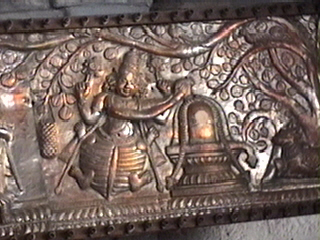This legend is of great importance both in Saivite
and Vaishnavite system of beliefs. The devas and the asuras (gods and
demons) united in their efforts to churn the celestial ocean of milk (ksheerasaagaram),
in quest of Amrita (the nectar of life and immortality). This mammoth
task was carried out with the Mandara Mount as the churning stick and the
mythological snake Vasuki as the rope.
Vishnu assumed the Koorma
avatara (tortoise) to hold the Mandara mountain in place and to prevent it from sinking
into the ocean. Lakshmi the Goddess of wealth emerged from the ocean, and so did the moon
god Chandra. Then came the dreaded poision, Kaalakoota. The gods and
demons appealed to Shiva to save them from the fumes that emanated from the poison.
Without hesitation, Shiva consumed the poison, and retained it in his throat, which turned
blue on account of the poison, leading to the name Neelakantha or Vishaapaharana
Murthy.

This instance of all of the gods, mortals and demons
worshipping Shiva, for the act of saving the Universe from the dreaded poison, is believed
to have occured during the pradosha kaala (the time
period just before sun set). The pradosha kaala puja in Shiva temples is considered to be
very sacred on all occurrences of pradosha days, two days before
the new moon and the full moon each month. The pradosha kaala puja at the Kapaleeswarar temple at Mylapore - Chennai attracts
thousands of devotees with amazing regularity.
The legend does not end here. Their obstacle out of
the way, the devas and asuras continued to churn the ocean in quest of their ultimate
goal, and were rewarded with the spectacle of the divine physician Dhanvantari
emerging out of the ocean with a pot bearing the celestial nectar. A fierce tussle
followed between the gods and the demons over the issue of sharing the nectar of
immortality. Vishnu the protector of good intervened, took the form of an enchantress Mohini,
appeared on the spot, charmed the asuras, and served all of the nectar to the devas, and
thereby protected the universe from the calamity that would have occurred if the asuras
had attained immortality.
The legend still does not end here. Two of the asuras,
aware of Mohini's trickery took the guise of devas and begot a dose of the nectar from
her. Vishnu discovered their act, only when they had consumed half their portion of
Amrita, and proceded to destroy them. Protected by the nectar of immortality, the demons
took the form of Rahu and Ketu. Rahu with a
snakes head and a human body, and Ketu with a human head and a snake's body are regarded
as celestial bodies - shadow planets, or the node positions at which eclipses are caused.
Rahu is the ascending node while Ketu is the descending node. Popular belief has it that
eclipses are caused when Rahu or Ketu swallow the moon or the sun.
Yet another legend has it that the serpent Vasuki
consumed the celestial nectar much against the wishes of the sun and the moon, and that it
was split into two, and still continued to live in the form of Rahu and Ketu, the so
called enemies of the sun and the moon, threatening to eclispse them at the right moment!
Rahu is believed to have worshipped Shiva at Tirunageswaram near Thanjavur-Tamilnadu, and is
enshrined there. Ketu is believed to have worshipped Shiva at Perumpallam near Mayiladuturai (Chidambaram - Tamilnadu) and is enshrined
there. Sri Kalahasti near Tirupati in Andhra Pradesh, enshrines Shiva who was
worshipped by both Rahu and Ketu. Special worship services are carried out in all these
temples during eclipses.
Mohini avatara sevai is celebrated in
many Vaishnavite temples, where Vishnu is decorated as Mohini the enchantress. Vishnu
worshipping Shiva in his Koorma avatara is enshrined at Tirukkachur,
near Chennai.
